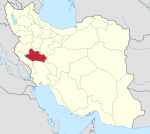Rumeshkhan County
| Rumeshkan County شهرستان رومشکان Rūmeshgān County[1] | |
|---|---|
| County | |
| Coordinates: 33°17′N 47°33′E / 33.283°N 47.550°ECoordinates: 33°17′N 47°33′E / 33.283°N 47.550°E | |
| Country |
|
| Province | Lorestan Province |
| Capital | Chaqabol |
| Bakhsh (Districts) | |
| Area[2] | |
| • Total | 853 km2 (329 sq mi) |
| Elevation mean elevation | 1,095 m (3,593 ft) |
| Population (2011)[2] | |
| • Total | 38,701 |
| Time zone | UTC+3:30 (IRST) |
| • Summer (DST) | UTC+4:30 (IRDT) |
Rumeshkan County (Persian: شهرستان رومشکان) is a county in southwestern Lorestan Province, Iran. At the 2011 census, its population was 38,701, in 7,423 families.[3] The county has one city, Chaqabol, the administrative headquarters. The county is subdivided into two main districts: Central District and Suri District.[4]
Geography and climate
Rumeshkan County lies between 32 degrees 15 minutes to 33 degrees 25 minutes north latitude, and between 47 degrees 20 minutes to 47 degrees 40 minutes east longitude.[2] The county is mountainous with major northwest to southeast trending ranges. The lower plains are generally high desert steppe.[5]
Rumeshkan experiences a temperate and semi-dry climate with maximum temperatures in summer around 40 °C (104 °F). The minimum temperature in winter averages about −7 °C (19 °F). Average annual rainfall is 450 mm.[6]
History
Archaeological evidence shows the influence of Roman style architecture,[7] and the name of this region is a compound of the words Rum (Romans) and eshkan (break) and it is believed that this area is where Eastern Roman Empire was defeated.[6]
The county was officially created in April 2013 from part of Kuhdasht County,[8][9][10] and the first governor was appointed in February the following year.[11]
Economy
The principle occupations in Rumeshkan County are animal husbantry, and farming in the river valleys.[12] Most of the crops are cereals, especially barley and wheat. In many of the villages and around Chaqabol, deep wells provide for irrigated agriculture and vegetable and melons are grown. These become a cash crop near Chaqabol and where transportation is available to other cities.[12] In some areas orchards have been planted.[6] In the 21st century, Rumeshkan began to experience severe drought which has decreased agricultural production and impoverished some farmers.[13]
In 2015 the government in cooperation with the private sector opened a steel mill.[8][14]
Scenic areas
- Drvnshr Cave (غار درونشر), a limestone cave with a variety of cave formations.[15][16]
- Kalmakarra Cave (Kalmakareh Cave) has been occupied by humans since pre-historic time and has yielded up artifacts from several civilizations.[6][17]
- Zagheh Castle (قلعه زاخه), two kilometers east of Chaqabol, is a ruin of a Roman fort with later Sassanid additions.[7]
- Mount Vyznhar (Vznyar) is the highest mountain in the county. On its slopes are the ruins of Kohzad Castle.[5]
See also
References
- ↑ Rūmeshgān (Approved - N) at GEOnet Names Server, United States National Geospatial-Intelligence Agency
- 1 2 3 "سیمای اقتصادی،اجتماعی و فرهنگی شهرستان رومشکان" [Profile of economic, social and cultural aspects of Rumeshkan County]. Rumeshkan News (in Persian). 6 April 2015. Archived from the original on 27 September 2015.
- ↑ "Census of the Islamic Republic of Iran, 1390 (2011)". Islamic Republic of Iran. Archived from the original (Excel) on 2016-10-06.
- ↑ "Rumeshkan: Divisions" (in Persian). Lorestan province. Archived from the original on 26 September 2015.
- 1 2 "Rumeshkan: Geographical location" (in Persian). Lorestan province. Archived from the original on 26 September 2015.
- 1 2 3 4 "Rumeshkan" (in Persian). Tishineh. Archived from the original on 22 March 2015.
- 1 2 "قلعه زاخه هنوز در زیر خاک پنهان است!" [Zagheh Castle remains buried!] (in Persian). Aflak Online. Archived from the original on 26 September 2015.
- 1 2 Ibrahim, D. (8 June 2015). "با حضور معاون پارلمانی رییس جمهور/عملیات اجرایی ساخت کارخانه ذوب آهن شهرستان رومشکان آغاز شد" [With the deputy parliamentary president present, Rumeshkan began construction of a steel mill]. Mir Malas News (in Persian). Archived from the original on 26 September 2015.
- ↑ "Rumeshkan: Governance" (in Persian). Lorestan province. Archived from the original on 26 September 2015.
- ↑ "وزارت کشور شماره ۱۰۶۲۲۸/ت۴۹۲۴۳هـ" [No. 106228/49243 of the Ministry of Interior] (in Persian). Laws and Regulations Portal of the Islamic Republic of Iran. Archived from the original on 28 September 2015.
- ↑ "اولین فرماندار رومشکان معارفه شد" [The first governor of Rumeshkan was appointed]. Mir Malas News (in Persian). 8 February 2014. Archived from the original on 14 February 2014.
- 1 2 "Rumeshkan: Economy" (in Persian). Lorestan province. Archived from the original on 26 September 2015.
- ↑ Beyranvand, Sakineh (14 June 2015). "لرستان دومین حوضه پرباران ایران دست به گریبان بحران خشکسالی" [Lorestan's second river basin faces drought]. Rumeshkan News (in Persian). Archived from the original on 26 September 2015.
- ↑ Islamic Republic News Agency (10 June 2015). "عملیات اجرایی ساخت کارخانه ذوبآهن رومشکان در لرستان آغاز شد" [Steel plant began operations in Lorestan Rumeshkan]. Stka Entrepreneurship Center (مرکز کارآفرینی ستکا می) (in Persian). Archived from the original on 26 September 2015.
- ↑ "اولین تصاویر از "غار درونشر" رومشگان با حضور کارشناسان میراث فرهنگی لرستان" [The first images from "Drvnshr Cave", Rumeshkan, with experts from the Lorestan Cultural Heritage Center]. Mir Malas News (in Persian). 20 September 2015. Archived from the original on 26 September 2015.
- ↑ "تصاویر اولیه از غار شگفت انگیز رومشکان" [Early pictures of the amazing cave in Rumeshkan]. Rumeshkan News (in Persian). 20 September 2015. Archived from the original on 26 September 2015.
- ↑ "Kalmakareh Cave". Iran Daily. 5 April 2015. Archived from the original on 26 September 2015.
Further reading
- Schmidt, Erich Friedrich; van Loon, Maurits Nanning & Curvers, Hans H. (1989). The Holmes Expeditions to Luristan. University of Chicago Oriental Institute publications, volume 108. Chicago: Oriental Institute of the University of Chicago. ISBN 978-0-918986-53-5.
